Editor's Note: This article was orginally published July 18, 2014. Some of the information may no longer be relevant, so please use it at your discretion.
After teaching a seminar recently, I received an email from an attendee, who works in a shop in Mississippi, asking me about one of the topics I discussed in the class. Essentially, I had reminded attendees the automakers recommend (and I-CAR teaches) that before technicians do any welding on vehicles, they should first disconnect the battery of the vehicle and remove (or pull back) any wiring harness or electronic components that are within 12" of the weld area.
The gentleman from Mississippi asked about some of the electrical issues if the technician is using a “memory saver,” which is a low-cost device that typically use a 9V battery plugged into the car’s auxiliary power outlet (or cigarette lighter) to keep power directed toward the car’s radio or other components to maintain their memory settings. The Mississippi technician wondered if a memory saver was a good alternative to disconnecting the battery and losing some electronic memory information.
I was pretty sure I knew the answer to that question but decided to put it out to some of the technical experts I know and respect in this industry. Their unanimous conclusion: They don’t recommend the use of memory savers.
“We do not use memory savers,” said Will Latuff, manager of the fourth-generation Latuff Brothers collision repair business in St. Paul, Minn. “They are not effective or worth the risk. I-CAR also teaches not to use them.”
Jeff Peevy, I-CAR’s director of field operations, concurred.
“A memory saver can complete circuits that removing the battery opens in order to protect the system, and so a memory saver could put systems at risk,” Peevy said.
George Hogan, a business development manager with Axalta Coating Systems, agreed that welding has the potential to expose vehicle electronics to overly high voltages and amperages.
“There is also likely increased risk of fault codes being stored if the circuitry is exposed to unexpected signals if the modules are ‘awake,’ powered up from either a connected battery or a memory saver installed,” Hogan said.
Hogan said he recently spoke with an automaker engineer who noted that some vehicle electronic systems stay powered-up, even with the key off.
“Think of keyless entry systems, as they are always looking for a signal from the electronic key,” Hogan said. This could put these systems at additional risk if welding is done on the vehicle without appropriate steps being taken first.
“I agree with the others,” wrote Chuck Olsen, director of advanced diagnostics and technical support for Collision Diagnostic Services, the company that can remotely read and reset diagnostic codes on a vehicle anywhere in the country using a tool a shop connects to the vehicle and the Internet. “A memory saver installed while making repairs provides an electrical path through the system and defeats the purpose of removing the battery. They may be okay to use for a simple battery replacement procedure but not during other repairs.”
Larry Montanez, a former I-CAR instructor and area training coordinator in the Northeastern United States and a collision damage analyst with P&L Consultants, LLC, and Lange Technical Services, Ltd., also weighed in on the topic.
“I do not recommend memory savers, nor does I-CAR,” Montanez said. “Memory savers can allow airbags to deploy or allow some sensitive electronic components to become damaged. Electro-magnetic induction (EMI) can damage electronic modules. EMI can occasionally occur with MIG welding, but is very common with squeeze-type resistance spot welding, regardless of whether the battery is connected or not.”
Montanez also noted that many OEMs require the supplemental restraint system (SRS) modules be unplugged during welding to prevent a short to ground in the system.
“Memory savers are just a risk not worth taking,” he said.
I wasn’t surprised by the answers I got to the question, but it was good to confirm it from multiple reliable sources. Don’t take a chance on damaging expensive vehicle components by using a low-tech memory saver, but also, avoid work billed but not performed. Don’t charge to R&I something if you just set it back and don’t charge to R&I the battery if you just disconnect it at the terminal. If you do it, charge for it, and if you charge for it, do it.



